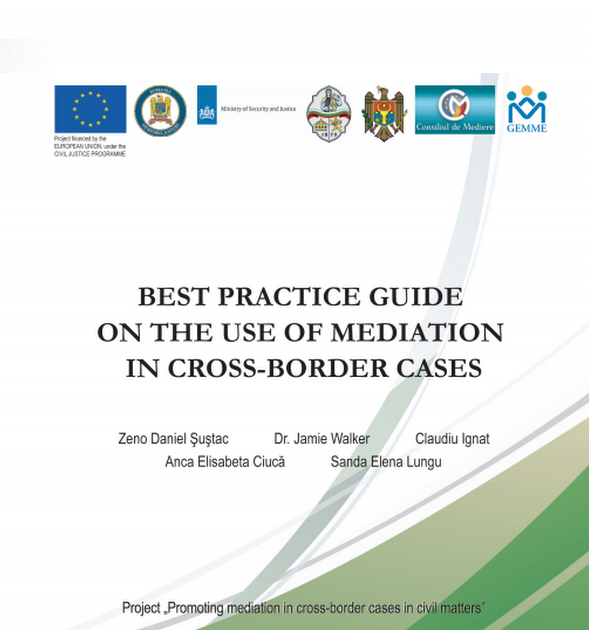Best practice guide on the use of mediation in cross border cases
Authors:
Zeno Daniel ŞUŞTAC, Romania
Dr. Jamie WALKER, Germany
Claudiu IGNAT, Romania
Anca Elisabeta CIUCĂ, Romania
Sanda Elena LUNGU, Romania
Mediation in cross border cases. Globalization and quasi-ubiquity of technologies associated to these have led to an exponential increase of interhuman and interinstitutional communication, with the consequence of rapidly escalation of differen- ces, disputes or misunderstandings, often transformed in litigations sent to the courts of law, according to historically established social practices. But, sometimes the act of justice rendered by the magistrates has the major disadvantage that it leaves one or more involved parties in a cause being unsatisfied with the decision; thus, it generates the image of a resolution formulated based on the “loser-winner” binomial. The consequence of this type of perception of litigants is often, besides the preservation of their conflicting status, the prolongation of judicial dispute; this is due to the will of revenge, with additional costs in time and money for both the parties and the judiciary. The mediation as an alternative method of conflict resolution, starts, right from the beginning, from the principle of counterbalancing the parties’ interests, of the remanence of an agreement obtained based on their free will, sustainable and perceived as mutually beneficial. This fact, in the context of the globalization phenomenon, confers mediation the quality of being a cross-border and often cross-cultural method with a universal value, of conflict approach and resolution.
The citizen’s guidelines concerning cross-border disputes in the European Union suggests, as a prioritary method of the resolution thereof, an amicable manner of approach, a resolution way alternative to justice, whenever such a step is possible.
The concern for establishing certain criteria off balancing gains and losses must exceed, for the involved parties, the barrier of their own interests with their common interest in the first place. In this context, mediation as an alternative dispute resolution method brings the possibility of introducing a neutral and impartial third-party who draws up the general lines in the conflict between parties, in the attempt to identity a beneficial resolution for all parties involved, all the more in the field of cross-border conflict mediation. The mediator’s role, as a facilitator of the discussions, is to bring in the center of negotiations the parties’ wishes, in order to encourage the shaping of an agreement between the parties involved.
On the European Union level, mediation was constantly stimulated by the passing of certain efficient implementation mechanisms. The right to free movement of the citizens of the member states significantly multiplies the perspectives of intercultural bridging and it implicitly increases the possibility that conflicts arise between persons in different member EU states.
The resolution of cross-border conflicts by methods alternative to classic justice is of high interest to each member state of the European Union. Over time, international instruments were adopted, on the level of both the European Council and the European Union.
An overview on the chronology when the various documents concerning alternative dispute resolution methods show the increasing concern for this area, first of the European Council and then, especially after the consolidation in its current form, of the European union. Starting with the 80s, the continental level approach of the ADR methods grew in intensity – from Recommendations of the Committee of Ministers concerning the access to justice (1981) or diminishing the tasks of courts of law (1986) to the level of the European Council – until the most important document of the European Union concerning mediation: Directive 2008/52/EC. One must note the fact that from simple recom- mendations, the trend is towards a European level unification, by means of Directives which, according to their programmatic value, set forth the goals that need to be attained by member states, leaving the choice of means to the national authorities. In order for the principles provided by the directives to become effective at a citizen level, the national legislator must pass transposition acts to the national legislation, whereby the latter shall be adapted to the goals defined in the directives. Thus, we witness a historical process with predictable development and implementation consequences in the field of alternative dispute resolution solutions, at both a European and national level, to the continuous increase of the ADR methods impact in the field of culture and jurisprudence of the general public.
Most of the European Union countries have adopted a specific legislation concerning mediation; at an internal level, there are tither a mediation law, or specific provisions included in codes which encourage the resort to mediation. In this respect, mediation in cross-border conflicts is of high interest, already materialized since 2000, when the European Commission presented a Green Card on the alternative dispute resolution methods in civil and commercial matters. The green card was intended as a case study in performing alternative dispute resolution methods in the European Union; this study was resulted from counseling with member states and other parties involved, in order to improve the general framework in the field of mediation.
The foreign element is the one that confers mediation with cross-border mediation values. This results in a factual circumstance due to which a legal report sis connected to two or more than two law systems; in this case, law systems of certain member states of the European Union. In cross-border environments, the parties are law students, natural or legal persons, pertaining to several member states.
The book „Best practice guide on the use of mediation in cross border cases“ can be downloaded here



This is a significant guide about the topic of mediation. Really, all thanks to the authors and the recommendation to all of those to read this guide.
Essential guide to international mediation cases. Theoretical and practical approach combined with sharp emphasis on following common sense and life wisdom while mediating. It is not all about rules and procedures. It is the most important to understand parties and lead them to mutually satisfying outcome.
Look no further.
Useful and inspiring book!
An impressive guide, my compliments to the authors.
Great book!
Zeno Sustac is our new member. 🙂